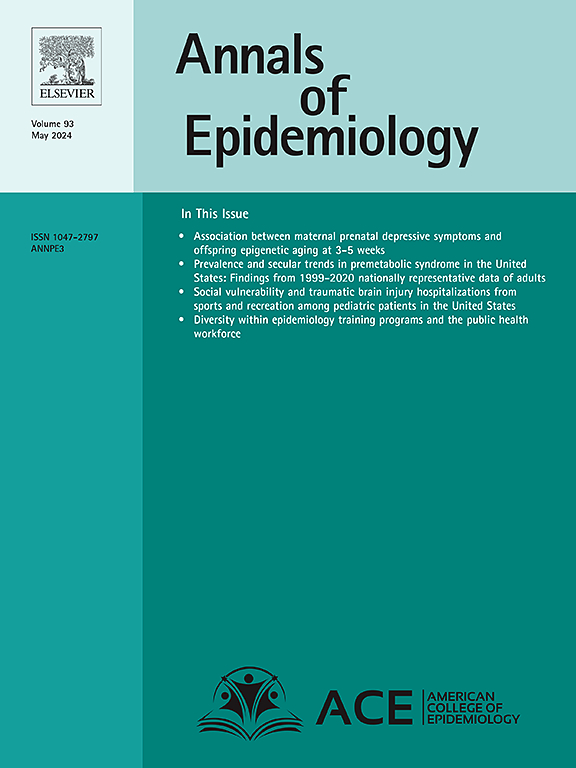Outpatient insurance data indicate increased numbers of Parvovirus B19 infections and -associated miscarriages during the 2024 epidemic in the German federal state Saarland
IF 3
3区 医学
Q1 PUBLIC, ENVIRONMENTAL & OCCUPATIONAL HEALTH
引用次数: 0
Abstract
Objectives
Parvovirus B19 (B19V) infection usually causes mild diseases such as Erythema infectiosum in immunocompetent individuals. During pregnancy, however, it can lead to fetal anemia, hydrops fetalis or fetal death. To date, neither B19V infections nor attributable complications are notified in Germany. At the beginning of 2024, we observed an increased number of B19V infections in pregnant women at Saarland University Hospital.
Study design and methods
To investigate this further, we analyzed retrospective ICD-10-coded aggregated outpatient health insurance data over the last 10 years in the German federal state Saarland on B19V infections, stratified by sex and age groups, and on B19V infection-associated pregnancies and miscarriages.
Results
The first B19V epidemic after the SARS-CoV-2 pandemic began in the third quarter of 2023, peaked in the first quarter of 2024 and remained stable in the second quarter of 2024. Compared to the last two pre-pandemic B19V epidemics in 2017 and 2018, the number of infections were 14 and 6 times higher respectively. In pregnant women, the number of B19V infections increased 17.5-fold in the first quarter of 2024 and by more than 60 % in the second quarter, which was accompanied by a marked increase in miscarriages.
Conclusions
These are the first objective data documenting an unusually strong B19V epidemic in a German federal state after the SARS-CoV-2 pandemic, with a steep rise of B19V infections in pregnant women and associated miscarriages. The establishment of early warning systems should be considered to prevent dramatic consequences of future B19V epidemics.
门诊保险数据显示,在2024年德国联邦州萨尔州流行期间,细小病毒B19感染和相关流产的数量增加。
目的:细小病毒B19 (B19V)感染通常在免疫正常的个体中引起轻微的疾病,如感染性红斑。然而,在怀孕期间,它可能导致胎儿贫血、胎儿水肿或胎儿死亡。迄今为止,德国没有报告B19V感染或可归因于的并发症。在2024年初,我们观察到萨尔大学医院孕妇中B19V感染的数量有所增加。研究设计和方法:为了进一步研究这一点,我们分析了回顾性icd -10编码的德国联邦州萨尔州过去10年的B19V感染汇总门诊医疗保险数据,按性别和年龄组分层,以及B19V感染相关的妊娠和流产。结果:SARS-CoV-2大流行后的第一次B19V流行始于2023年第三季度,2024年第一季度达到高峰,2024年第二季度保持稳定。与2017年和2018年的前两次B19V大流行相比,感染人数分别增加了14倍和6倍。在孕妇中,感染B19V病毒的人数在2024年第一季度增加了17.5倍,在第二季度增加了60%以上,同时流产率显著增加。结论:这些是记录德国联邦州在SARS-CoV-2大流行后异常强烈的B19V流行的第一个客观数据,孕妇感染B19V和相关流产急剧上升。应该考虑建立早期预警系统,以防止今后B19V流行病的严重后果。
本文章由计算机程序翻译,如有差异,请以英文原文为准。
求助全文
约1分钟内获得全文
求助全文
来源期刊

Annals of Epidemiology
医学-公共卫生、环境卫生与职业卫生
CiteScore
7.40
自引率
1.80%
发文量
207
审稿时长
59 days
期刊介绍:
The journal emphasizes the application of epidemiologic methods to issues that affect the distribution and determinants of human illness in diverse contexts. Its primary focus is on chronic and acute conditions of diverse etiologies and of major importance to clinical medicine, public health, and health care delivery.
 求助内容:
求助内容: 应助结果提醒方式:
应助结果提醒方式:


